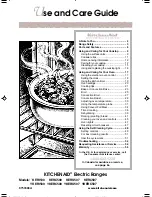
HOBO Pro v2 User’s Manual
3
Operation
A light (LED) in the communications window of the logger
confirms logger operation. (In brightly lit areas, it may be
necessary to shade the logger to see the LED blink.) The
following table explains when the light blinks during logger
operation:
When:
The “OK” light:
The logger is logging
Blinks once every one to four
seconds (the shorter the logging
interval, the faster the light blinks);
blinks when logging a sample
The logger is awaiting a
start because it was
launched in Start At
Interval or Delayed Start
mode
Blinks once every eight seconds
until logging begins
Sample and event logging
The logger can record two types of data: samples and events.
Samples are the sensor measurements recorded at each logging
interval (for example, temperature every minute). Events are
independent occurrences triggered by a logger activity, such as
Bad Battery or Host Connected. Events help you determine what
was happening while the logger was logging.
The logger stores 64K of data, and can record over 42,000 12-bit
measurements.
Deploying and protecting the logger
•
To clean the logger’s case, use a sponge with warm, soapy
water.
•
Use the included clamp to mount the
logger to a surface. The clamp has two
holes for the screws, 44 mm (1.7 inches)
apart.
The clamp is slightly tapered to
accommodate the logger. Install the
clamp so the logger fits better with its
communication window facing up. This
will prevent condensation from pooling
around the sensor and/or grommet.
•
A solar shield is recommended if the
logger will be exposed to sunshine.
•
Periodically inspect the three desiccant packs located in the
logger cap. If they are not bright blue, dry them following the
instructions below.
To dry a desiccant pack, remove it from the logger cap and
leave in a warm (
≤
70
o
C (158
o
F), dry location until the bright
blue color is restored. (Refer to the “Battery” section for
instructions on removing and replacing the logger cap.).
If a desiccant pack remains pink and will not turn blue, replace
it with a new desiccant pack (Onset Part #: DESICCANT1)
Replacing the RH sensor
The RH sensor (on models U23-001 and U23-002) is protected
by an ASA styrene polymer cap and a modified hydrophobic
polyethersulfone fluid barrier membrane that allows vapor to
penetrate while protecting the sensor from condensation.
RH sensor performance may degrade over time. To replace the
RH sensor in your logger, refer to the diagram and instructions
for your logger:
U23-001
1.
Turn the RH sensor cap counter-clockwise slightly and pull
to remove it. Discard the sensor cap, membrane, and o-ring.
Clean the sensor end of the logger.
2.
There may be a spacer installed on the RH Sensor Board.
Remove and discard the spacer.
3.
Note the orientation of the small circuit board containing the
RH sensor. With a pair of needle-nose pliers, grip the sensor
board pins. Pull out and discard the board.
4.
Use needle-nose pliers to hold the pins on the new sensor
board, push the board gently but firmly and install it in the
same orientation as the old board. Make sure it engages with
the pins inside the logger housing. Do not touch the sensor
itself; only touch the sides of the board.
5.
Install the new spacer on the sensor board by placing the
spacer onto the third pin from the left (use the topmost hole
on the spacer instead of the center hole).
6.
Make sure the o-ring is clean and seated properly, and set the
protective membrane on top (either side can face up).
7.
Put the sensor cap back on. Push down and turn it slightly
clockwise to close it securely. Do not force it. If the cap does
not go on easily, the sensor may be installed incorrectly.
Check the sensor orientation and try again.
8.
Check logger status in HOBOware to verify the RH reading.
Logger
RH Sensor Board
Spacer
O-ring
Protective Membrane
RH Sensor Cap
WARNING: Do not touch
the actual sensor (black
chip). Doing so may
compromise accuracy.
Face-on view with spacer installed
RH Sensor






















